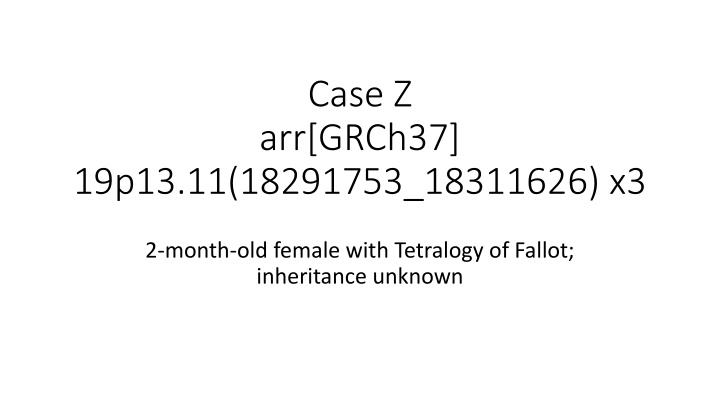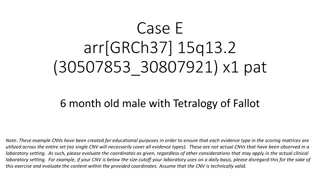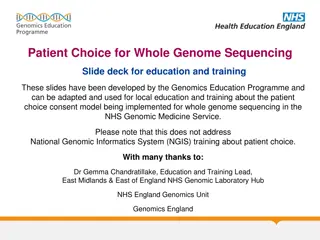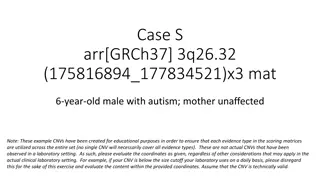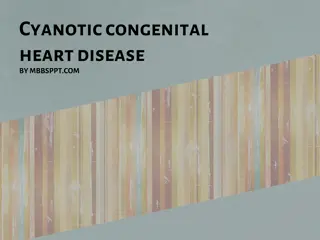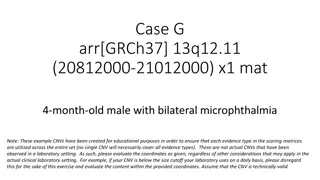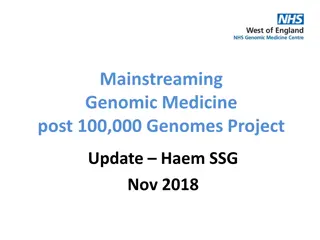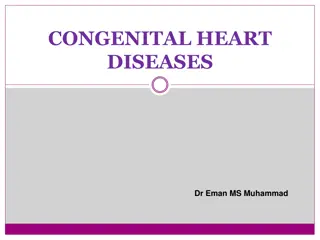Genomic Evaluation of a 2-Month-Old Female with Tetralogy of Fallot
This case involves a 2-month-old female with Tetralogy of Fallot, carrying a genetic variation in the 19p13.11 region. The evaluation process includes assessing genes, known dosage sensitivity, gene count, and detailed analysis of the duplication found in the DGV Gold Standard Dataset. The frequency of the variation is above the 1% threshold, prompting consideration of classifying it as benign based on population frequency data. Further research is suggested to gather more information about this genomic area.
Download Presentation

Please find below an Image/Link to download the presentation.
The content on the website is provided AS IS for your information and personal use only. It may not be sold, licensed, or shared on other websites without obtaining consent from the author.If you encounter any issues during the download, it is possible that the publisher has removed the file from their server.
You are allowed to download the files provided on this website for personal or commercial use, subject to the condition that they are used lawfully. All files are the property of their respective owners.
The content on the website is provided AS IS for your information and personal use only. It may not be sold, licensed, or shared on other websites without obtaining consent from the author.
E N D
Presentation Transcript
Case Z arr[GRCh37] 19p13.11(18291753_18311626) x3 2-month-old female with Tetralogy of Fallot; inheritance unknown
Clinical information arr [GRCh37] 19p13.11(18291753_18311626) x3 2-month-old female with Tetralogy of Fallot Inheritance information not available For the sake of example, assume the size of this CNV is one that is reliably detected by your platform and meets your reporting requirements. Use the GAIN scoring metric
Section 1: Initial Assessment of Genomic Content Our case Genes Involved Contains protein-coding genes (Category 1A) 0 points, continue evaluation Total: 0 points
Section 2: Evaluation of Known Dosage Sensitive (or Benign) Genes/Regions No known dosage sensitive or benign genes/genomic regions. 0 points, continue evaluation Total: 0 points
Section 3: Gene Count Contains 2 protein-coding genes (Category 3A) 0 points, continue evaluation Total: 0 points
Section 4: Detailed Evaluation of Genomic Content There is a similarly-sized duplication in the DGV Gold Standard Dataset let s look into this further.
This frequency is >> the 1% threshold in category 4O should we assign -1 points and classify this CNV as benign?
Check the number of variants/number of samples tested before automatically classifying something as Benign based on population frequency. In this instance, the frequency of 12.9% is based on 4 observations across 31 samples tested.
Can we find any other information about this area of the genome?
How frequent is too frequent for your phenotype? The 1% threshold for category 4O is a general guide For some phenotypes, this will be too high In some situations, this may be too low For certain phenotypes, enough information may be available to calculate the maximum expected allele frequency of a disease- causing variant in the general population Use the CardioDB Allele Frequency calculator To be conservative (and end up with the most generous credible allele frequency/allele count), select: The highest (i.e., most frequent) reported disease prevalence The most frequent single genetic cause The lowest credible estimate of penetrance
PMID: 28518168 Whiffin et al. 2017 http://cardiodb.org/allelefrequencyapp/ Estimated prevalence of ToF from NORD (https://rarediseases.org/rare-diseases/tetralogy-of-fallot/) Per OMIM (#187500), the most common genetic cause of ToF is the 22q11.2 deletion, found in ~7% of patients (Rauch et al. 2010). The allelic heterogeneity is set at 0.07 to indicate that no single variant should be more frequent than the 22q11.2 deletion. See the directions at the bottom of the web page for more information on how to utilize these fields. Allele frequency of our comparable gnomAD variant: 0.003643 Allele Count: 79 (and 4 homozygotes) Default penetrance set at 0.5. Used number of samples tested from gnomAD SV.
What if we changed the penetrance? Allele frequency of our comparable gnomAD variant: 0.003643 Allele Count: 79 (and 4 homozygotes)
What if we changed the penetrance? Allele frequency of our comparable gnomAD variant: 0.003643 Allele Count: 79 (and 4 homozygotes)
How should we score this variant? Even though the overall frequency in the larger sample isn t 1%, in this scenario, it still makes sense to assign -1 points. The frequency in the East Asian population was almost 3% with over 2000 alleles tested. Even if we did not have this information, given the rarity of our phenotype, the overall frequency of the comparable variant observed in the larger sample (gnomAD SV) is too high to make sense as possible cause for Tetralogy of Fallot (using the Cardiodb calculator) The high frequency from DGV alone would not be enough to warrant -1 due to the sample size for that particular variant. Note that there are many other variants in the DGV gold standard dataset that do have appropriately high sample sizes. Always check this information! To complete the evaluation, do a literature search to ensure: No reports of phenotype associated with duplication of MPV17L2 No reports of phenotype associated with potential loss of RAB3A Assuming none, this CNV can be classified as Benign
Todays Attendance URL and QR code: https://tinyurl.com/AttendanceFeb27
